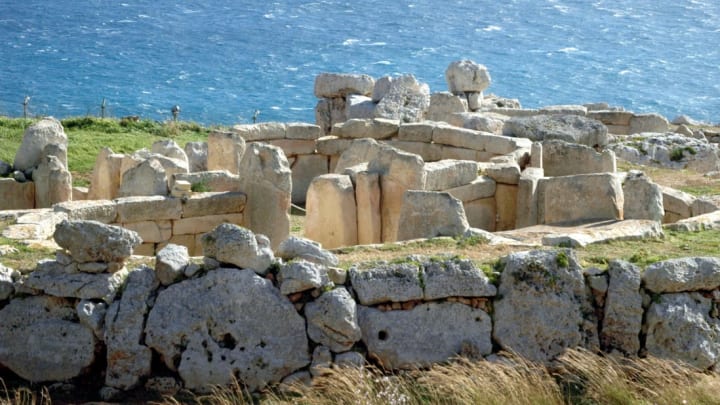A thousand years before Stonehenge, when many Paleolithic peoples were still hunting and gathering, the Maltese were building some of the biggest, earliest, and most epic monuments on the planet.
Along with its tinier neighbors Gozo and Comino, the island of Malta is covered with more than 50 elaborately carved stone temples. Each is decorated uniquely in geometric spiral, plant, or animal themes, but most follow the same floorplan, with an oval courtyard that leads up to a southeast-facing monumental lintel doorway. The semi-circular chambers within are often astronomically aligned, so that the rising sun is framed between the stones of the closer rooms on the mornings of an equinox. Though the sizes of stone vary, many of the standing building blocks weigh upwards of 50 tons.
Hagar Qim temple (3600-3200 BCE). Dr_zoidberg, Flikr // CC BY-SA 2.0
Until the recent discovery of Gobekli Tepe in Turkey, the temples of Malta were officially considered the oldest man-made, free-standing structures in the world. Construction at the earliest temple, Ġgantija, began sometime around 4100 BCE. Comparatively, the famous pyramids at Giza were built from 2470 BCE onwards—right around the time the Maltese stopped designing their own monuments. Malta’s temples represent an island culture that was a wild outlier among its contemporaries, persisted for over 2000 years—and then mysteriously faded away.
WHO BUILT THEM?
All sorts of crazy theories have been proposed to explain Malta's buildings, including tales of aliens, Atlantis, and giants from a distant land who brought with them the highly technical skills needed to build these architectural anomalies. Meanwhile, others claimed the Maltese must have been influenced by more famous Aegean cultures like the Minoan and Mycenaean.
But it isn’t so. Archaeological investigations during the past century have revealed that Malta’s megalithic structures predate the first stirrings of culture in ancient Greece—and may, in fact, have inspired them. Nor were the temples the work of any foreign invaders or settlers. The building boom was an entirely local enterprise.
Some propose that Malta’s isolated island conditions inspired these monumental construction projects and off-beat architectural techniques. The first settlers may have been stranded there some 16,000 years ago at the end of the Ice Age by the rising tides of the Mediterranean, which filled in the land bridges that once connected Malta to Italy and to nearby islands, such as Sicily.
The first permanent inhabitants arrived from Sicily in the late 6th millennium BCE. Over the years they developed a complex agrarian society that appears to have been devoted to localized fertility goddesses, based on the hundreds of votive statues archaeologists have discovered in temples and in graves. This clay figurine of a reclining woman, perhaps a mother goddess, was found in the Hypogeum of the Hal Saflieni, a subterranean structure built at least 5000 years ago, where the graves of more than 7000 people have been unearthed.
Jvdc, Wikimedia Commons // CC BY-SA 3.0
HOW WERE THEY BUILT?
The Maltese didn’t even have the wheel yet when they erected these buildings. Nor did they have any kind of metal tools or systems of writing to pass on the blueprints. So how did they do it?
The quick answer: Ball bearings. Using a complicated system of carved grooves in the ground and stone, the obsidian-carved blocks of limestone were maneuvered into place via the use of pulleys and limestone balls specially crafted to roll the stones into place and re-align them if necessary.
WHAT HAPPENED TO THE MALTESE?
For 2000 years, the Maltese lived in a society of art and culture more advanced than most of their contemporaries. And then they disappeared mysteriously, around 2500 BCE, most likely amidst environmental turmoil. The islands were abandoned for centuries until a separate, unrelated Bronze Age population moved in.
A multinational investigation of Europe’s leading universities is investigating the root cause of the society’s collapse. FRAGSUS (Fragility and Sustainability In Restricted Island Environments) is peering into the past to divine ways in which the island’s ecosystem might have driven off its original inhabitants. And in so doing, they hope to be able to chart out a sustainable future for the Maltese and other island nations with similarly restricted resources.
